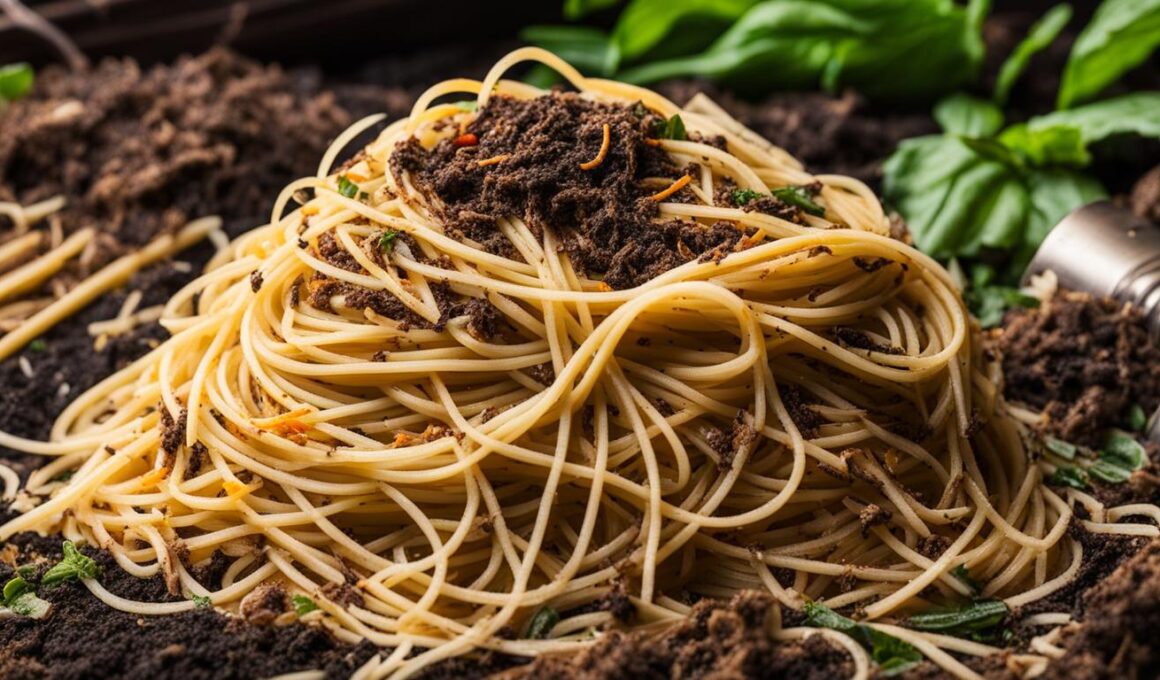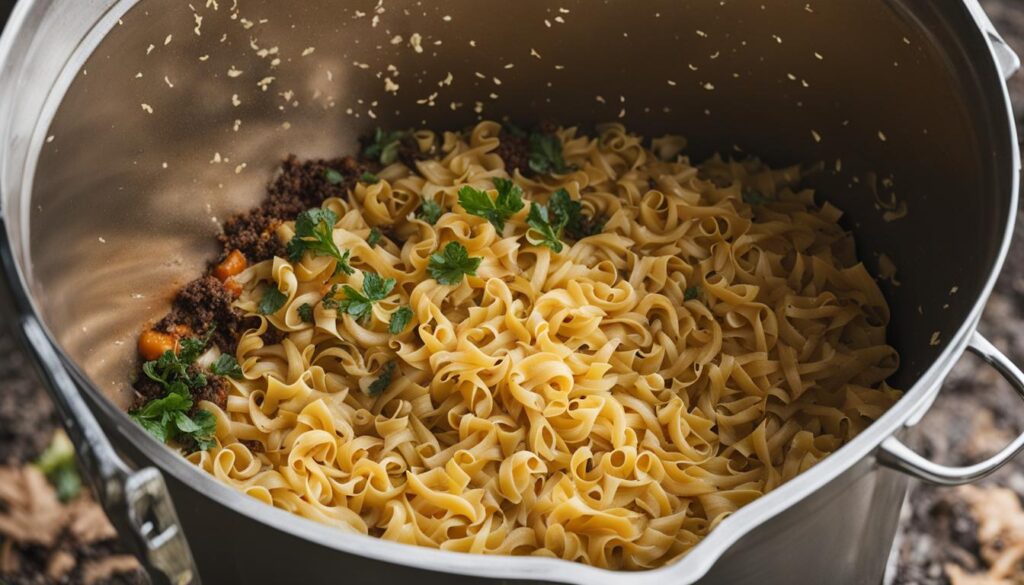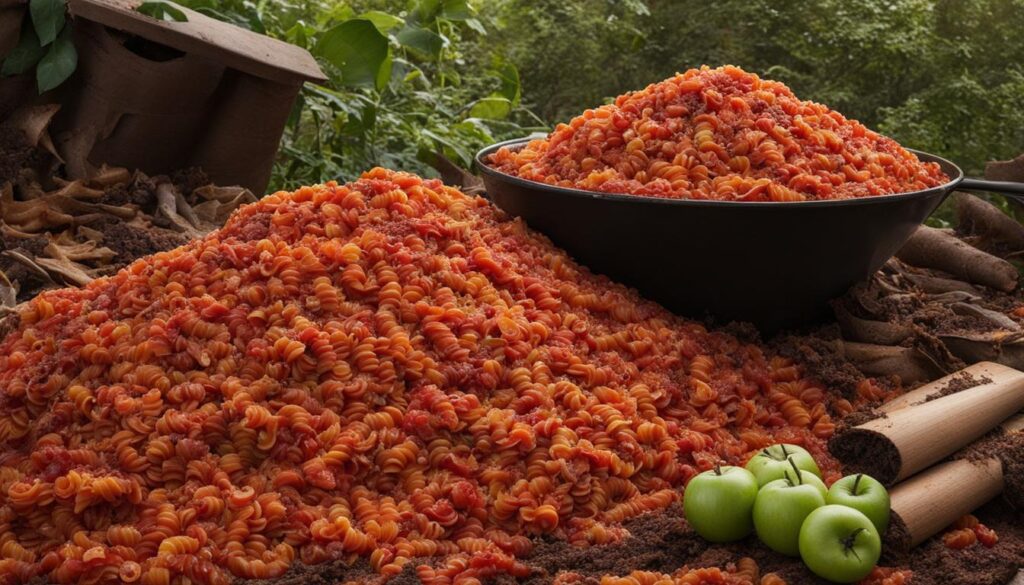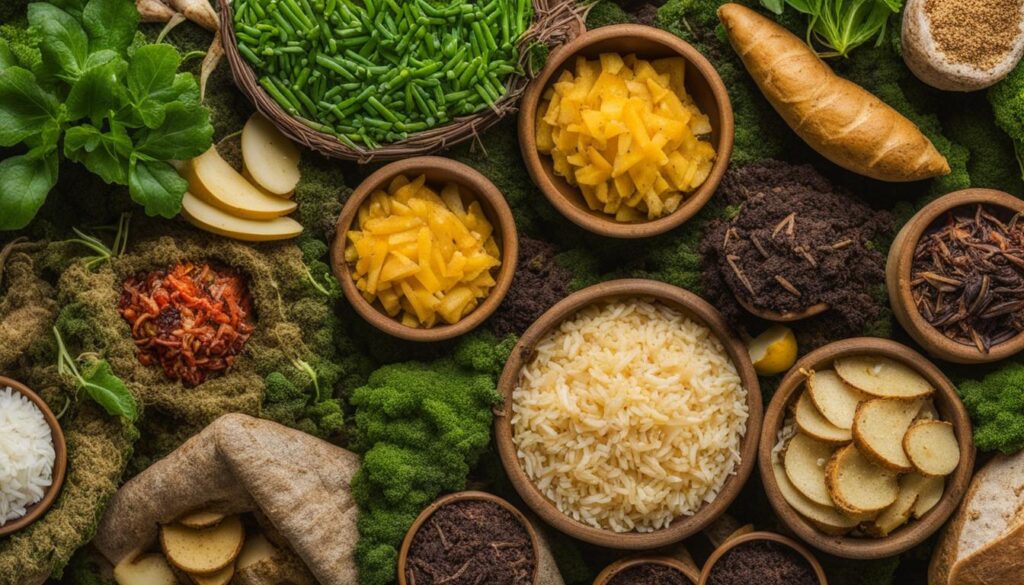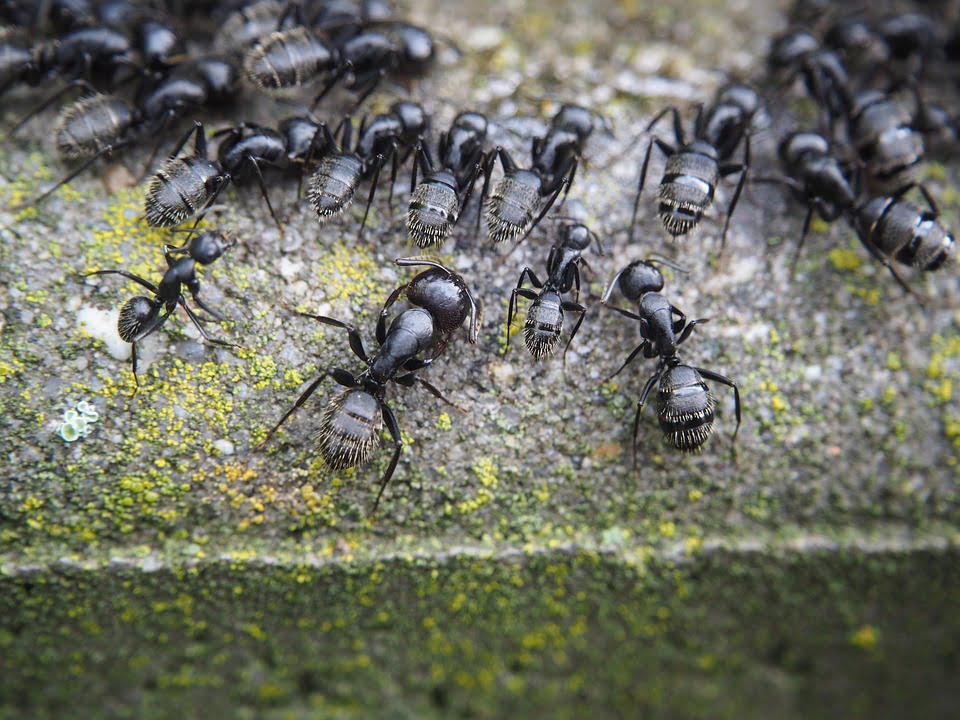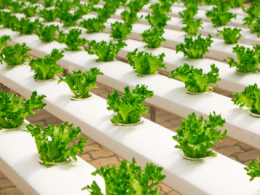If you’re looking for ways to reduce kitchen waste, composting pasta can be a great solution. Whether it’s cooked or uncooked, pasta is compostable and can contribute to creating nutrient-rich soil for your plants. However, there are some important considerations to keep in mind to ensure successful composting and avoid attracting pests.
Post Summary
- Composting pasta, cooked or uncooked, is a great way to reduce kitchen waste.
- Pasta is a nitrogen-rich material that adds nutrients to your compost pile.
- Cooked pasta tends to attract pests, so precautions like burying it deep or using a compost tumbler are recommended.
- Uncooked pasta breaks down quickly and is less attractive to pests, making it easier to compost.
- Pasta sauces, including tomato-based sauces, can be composted, but dairy-based or oily sauces should be added sparingly.
Is Pasta Safe to Compost?
Pasta is generally safe to compost, whether it is cooked or uncooked. When composting food scraps, including pasta, it is important to maintain a balance of moisture levels and a variety of compostable materials. Pasta is a nitrogen-rich material, which is beneficial for the composting process. It helps add nitrogen to your compost pile and promotes the breakdown of other organic matter. Additionally, pasta is relatively dry compared to other nitrogen-rich materials, which helps balance moisture levels in your compost bin.
Composting food scraps, such as pasta, allows you to recycle kitchen waste and reduce landfill waste. By composting pasta, you can create nutrient-rich compost that can be used to nourish your plants and improve soil quality. However, it is important to note that cooked pasta may attract pests and rodents, which can pose a challenge in composting. To avoid these issues, it is recommended to take precautions and implement strategies to deter pests.
Overall, composting pasta is a safe and effective way to reduce kitchen waste and promote sustainable gardening practices. By following composting guidelines and implementing proper precautions, you can successfully incorporate pasta into your compost pile and create nutrient-rich soil for your plants to thrive.
Pasta is a nitrogen-rich material, which adds nitrogen to your compost pile. Additionally, pasta helps balance moisture levels in your bin, as it is relatively dry compared to other nitrogen-rich materials.
Composting Cooked Pasta
Composting cooked pasta can pose some challenges, as it tends to attract pests that can harm your plants and interfere with the composting process. Pests such as rodents, flies, and maggots are drawn to the decomposing food scraps and can cause issues in your compost bin. To avoid these problems, it is important to take precautions when composting cooked pasta.
One effective way to prevent pests from being attracted to your compost bin is to ensure that it is tightly closed or use a compost tumbler, which provides better protection against pests. Burying the cooked pasta deep in the compost pile and covering it with carbon-rich materials, such as wood shavings or leaves, can also help deter pests and rodents.
By following these measures, you can minimize the chances of pests being attracted to your compost and ensure that the composting process continues smoothly. Remember to maintain a good balance of food scraps, carbon-rich materials, and moisture in your compost to create nutrient-rich soil for your plants.
Common Pests Attracted to Composted Cooked Pasta
| Pest | Description |
|---|---|
| Rodents | These pests are attracted to the food scraps in the compost, including cooked pasta. |
| Flies | Flies are drawn to the decomposing food and can lay eggs, leading to an infestation of maggots. |
| Maggots | Maggots are the larvae of flies and can be a sign of overripe or rotting food in the compost. |
By being mindful of these pests and taking the necessary precautions, you can successfully compost cooked pasta without causing harm to your plants or attracting unwanted visitors to your compost bin.
Composting Uncooked Pasta
When it comes to composting, uncooked pasta is an excellent ingredient to add to your compost pile. Not only is it less attractive to animals compared to cooked pasta, but it also breaks down quickly once it is exposed to moisture. To ensure successful composting of uncooked pasta, there are a few key considerations to keep in mind.
If you’re using an open compost bin, it’s important to place the uncooked pasta in a lidded container or bury it in the middle of the compost heap. This helps to deter animals from nibbling on the pasta and disrupting the composting process. Additionally, breaking larger pasta noodles into smaller pieces can expedite the decomposition process and ensure more even breakdown.
Another helpful tip is to spread the pasta scraps in an even layer and cover them with wood shavings or leaves. This provides an extra layer of insulation and helps to maintain the right moisture levels in the compost pile. By following these simple steps, you can effectively compost uncooked pasta and contribute to reducing kitchen waste.
Benefits of composting uncooked pasta:
- Less attractive to animals
- Breaks down quickly with moisture
- Contributes to reducing kitchen waste
Tips for composting uncooked pasta:
- Use a lidded container or bury the pasta in the middle of the compost heap
- Break larger pasta noodles into smaller pieces for faster decomposition
- Spread the pasta scraps in an even layer and cover with wood shavings or leaves to maintain moisture levels
Composting uncooked pasta is a simple and effective way to reduce kitchen waste and create nutrient-rich soil for your plants. By following these tips, you can successfully compost uncooked pasta and contribute to a more sustainable way of managing food scraps.
Composting Pasta Sauce
When it comes to composting pasta sauce, there are a few things to consider. Tomato-based sauces, like marinara or bolognese, can be composted. However, due to their slight acidity, it’s important to compost them in moderation. Adding too much tomato-based sauce to your compost pile can disrupt the pH balance and affect the decomposition process. To counter the acidity, you can add alkaline agents, such as wood ash, to help neutralize the sauce.
When dealing with creamy sauces that contain dairy products, it’s important to compost them with caution. Creamy sauces can attract pests, such as flies and rodents. To avoid this, consider limiting the amount of creamy sauce you add to your compost and mix it well with other compostable materials. This will help dilute the sauce and make it less appealing to pests.
For oily sauces, like pesto, it’s best to add them sparingly to your compost. Oils take a long time to break down and can disrupt the composting process. Diluting the sauce with water before adding it to the compost can help reduce the smell and moisture content. It’s also a good idea to add brown materials, like shredded paper, to absorb any excess oil and maintain a balanced compost pile.
| Sauce Type | Composting Tips |
|---|---|
| Tomato-based sauce | Compost in moderation. Add alkaline agents to counter acidity. |
| Creamy sauce | Compost with caution. Mix well with other compostable materials and limit the amount. |
| Oily sauce | Add sparingly. Dilute with water and add brown materials to absorb excess oil. |
In summary, you can compost pasta sauce, but it’s important to consider the type of sauce and take precautions to ensure proper decomposition. Composting tomato-based sauces in moderation and adding alkaline agents can help maintain a balanced pH level. When composting creamy sauces or oily sauces, be mindful of the amount and mix them well with other materials. By following these tips, you can effectively compost pasta sauce and contribute to reducing kitchen waste.
Composting Macaroni and Cheese
Composting macaroni and cheese is possible, although it requires some additional precautions due to the presence of dairy products. Mac and cheese typically contains high levels of moisture and fat, which can attract pests and disrupt the composting process if not managed properly.
To compost macaroni and cheese effectively, it is recommended to mix it with dry fibrous materials. Dry leaves, straw, or shredded paper can help balance the wetness and lack of texture in the mac and cheese, aiding in the decomposition process. Additionally, burying the mac and cheese deep in the compost pile can further prevent pests and minimize odors.
Note: It’s important to avoid composting whole potatoes as well to prevent potential issues with pests and anaerobic decomposition.
By taking these precautions and making sure to include macaroni and cheese in the compost in moderation, you can successfully compost this dairy-rich dish and contribute to reducing kitchen waste.
| Benefits of Composting Macaroni and Cheese | Considerations for Composting Macaroni and Cheese |
|---|---|
| – Reduces kitchen waste | – Mix mac and cheese with dry fibrous materials |
| – Creates nutrient-rich compost | – Bury mac and cheese deep in the compost pile |
| – Contributes to a sustainable waste management system | – Avoid excessive amounts of mac and cheese |
| – Use covered bins or compost tumblers to deter pests |
Composting Mac and Cheese Tips
- Mix mac and cheese with dry leaves, straw, or shredded paper to balance moisture levels.
- Bury mac and cheese deep in the compost pile to prevent pest infestations.
- Avoid adding excessive amounts of mac and cheese to your compost.
- Consider using covered bins or compost tumblers to deter pests from accessing the compost.
Potential Issues With Composting Pasta
When it comes to composting pasta, there are a few potential issues that you should be aware of. One common problem is attracting pests to your compost pile. The smell of decomposing pasta can be enticing to pests like rodents and flies. To avoid this, it’s important not to add too much pasta to your compost. Instead, make sure to bury it with other compostable materials inside your compost bin or tumbler. This will help prevent the strong smell of pasta from attracting unwanted pests.
Another issue to watch out for is adding big pieces of pasta to your compost. Large chunks of pasta can become compacted and create anaerobic conditions in your compost pile. This can lead to a foul smell and slow down the composting process. To avoid this, break the pasta into smaller pieces before adding it to your compost. This will help ensure proper airflow and decomposition.
Maintaining a balanced compost is crucial as well. Adding too much pasta can make it the dominant component in your compost, which can throw off the balance of carbon and nitrogen. To avoid this, make sure to add a variety of materials to your compost, such as leaves, grass clippings, and other compostable kitchen waste. By maintaining this balance, you’ll ensure the optimal conditions for composting pasta and other organic matter.
Potential Issues with Composting Pasta:
| Issue | Solution |
|---|---|
| Attracting pests | Avoid adding too much pasta, bury it with other compostable materials |
| Big pieces becoming anaerobic | Break pasta into smaller pieces before adding it to compost |
| Imbalanced compost | Add a variety of materials to maintain the balance of carbon and nitrogen |
By being mindful of these potential issues and taking the necessary precautions, you can successfully compost pasta and contribute to reducing kitchen waste in an eco-friendly way.
Can You Compost Other Starches?
Besides pasta, you can compost other starches as well. Potatoes, rice, bread, and other starchy foods can be added to your compost pile to reduce kitchen waste and create nutrient-rich soil for your plants. However, there are some precautions you should take to ensure successful composting.
When composting starches, it’s important to bury them deep in the compost pile to prevent attracting pests or rodents. This helps to keep the compost contained and inaccessible to animals, reducing the risk of infestations. Mixing the starches with other compostable materials, such as vegetable trimmings or coffee grounds, helps create a balanced compost mix.
Using a covered compost bin or compost tumbler can also help deter pests and maintain a controlled composting environment. These containers provide added protection and help regulate moisture levels. Breaking down clumped food and ensuring a balanced mixture of carbon-rich and nitrogen-rich materials further aids the composting process.
Precautions for Composting Other Starches:
- Bury the starches deep in the compost pile to deter pests.
- Mix the starches with other compostable materials.
- Consider using a covered compost bin or compost tumbler.
- Ensure a balanced mixture of carbon-rich and nitrogen-rich materials.
| Starch | Precautions |
|---|---|
| Potatoes | Check for signs of disease or fungus before composting. |
| Rice | Bury deep in the compost pile to discourage pests. |
| Bread | Avoid adding excessive amounts to prevent a strong smell. |
Composting Moldy Food and Paper Towels
Moldy food can be a valuable addition to your compost pile. The mold present on these food items actually helps speed up the decomposition process. When adding moldy food to your compost, be sure to place it in the center of the pile and cover it with brown materials, such as yard trimmings or newspapers. This will help create a balanced mixture of carbon-rich and nitrogen-rich materials, promoting healthy composting. Remember to avoid adding greasy or soiled paper towels to your compost, as they can disrupt airflow and create unpleasant odors.
Composting paper towels is a great way to reduce waste in your kitchen. Paper towels provide a source of carbon-rich brown material, which is essential for creating a balanced compost mixture. However, it’s important to avoid composting paper towels that have been used to clean up grease or oil. These can hinder proper airflow and lead to the development of unpleasant odors. Additionally, be cautious of using paper towels that have been used with commercial cleaning products, as they may contain chemicals that are not beneficial for the composting process.
Items Suitable for Composting
| Item | Suitable for Composting | Precautions |
|---|---|---|
| Moldy food | Yes | Place in the center of the compost pile and cover with brown materials |
| Greasy or soiled paper towels | No | Avoid adding to compost to prevent odors and disruption of airflow |
| Clean paper towels | Yes | Add to compost as a source of carbon-rich brown material |
By following these guidelines, you can effectively compost moldy food and paper towels, reducing waste in your kitchen and creating nutrient-rich compost for your garden. Remember to always maintain a balance of carbon-rich and nitrogen-rich materials in your compost pile to ensure optimal decomposition. Happy composting!
Can I Put Potato Peelings In My Compost Bin?
Potato peelings can be a valuable addition to your compost bin, but it’s important to take certain precautions to ensure successful composting. Before adding potato peelings to your compost, it’s crucial to check them for any signs of fungus, such as potato blight. Fungus spores can survive on the peelings and potentially harm the composting process. If you notice any signs of disease or fungus on the potato peelings, it’s best to avoid composting them to prevent any potential issues.
To compost potato peelings effectively, bury them deep in your mature compost pile. This helps to prevent any potential odor or pest problems that may arise from having the peelings exposed on the surface. By burying the potato peelings, you’re also ensuring that they have sufficient time to break down and contribute to the nutrient-rich compost.
Remember to maintain a balanced composting process by adding a variety of materials, such as other kitchen scraps, yard waste, and carbon-rich materials like shredded paper or dry leaves. This will help create optimal conditions for decomposition and produce high-quality compost for your garden or plants.
Keeping Pests Out of Your Compost
To ensure a successful composting process and prevent pests from infesting your compost, it’s important to take preventive measures. Pests such as rodents and flies can be attracted to the decomposing organic matter in your compost pile, causing potential issues. Here are some strategies you can implement to keep pests out of your compost:
Create a Closed Compost Tumbler
A closed compost tumbler is an effective solution for preventing pests from accessing your compost. These containers are sealed, keeping the compost contained and inaccessible to animals. They also help regulate moisture levels and temperature, creating an ideal environment for composting without the risk of attracting pests.
Cover Your Compost with Leaves or Wood Shavings
If you’re using an open compost bin, it’s essential to cover the compost with a layer of leaves or wood shavings. This helps deter pests by creating a physical barrier and minimizing the odor that may attract them. It also provides additional insulation for your compost, helping to maintain proper moisture levels and temperature.
Maintain Proper Compost Balance
Properly maintaining your compost by regularly turning it over and ensuring the right balance of green and brown materials can deter pests. This helps to speed up the decomposition process and minimize odors that may attract pests. Remember to avoid adding excessive amounts of pasta or other food scraps that can disrupt the compost’s balance and attract unwanted visitors.
By implementing these strategies, you can create a pest-free composting environment and ensure the success of your compost pile. Remember to monitor your compost regularly and make adjustments as needed to maintain optimal conditions for decomposition and nutrient-rich soil creation.
Conclusion
In conclusion, composting pasta is a great way to reduce kitchen waste and minimize landfill waste. Whether it’s cooked or uncooked, pasta can be composted to create nutrient-rich soil for your plants. However, it’s important to follow some composting tips to ensure the process is safe and effective.
To compost pasta successfully, avoid adding excessive amounts to your compost pile. Bury the pasta deep within the pile to prevent pests and rodents from being attracted to it. Consider using covered bins or compost tumblers to further deter pests and maintain a clean composting environment.
By composting pasta and other starchy foods, you’re actively contributing to a more sustainable way of managing kitchen waste. Remember to follow composting safety guidelines and maintain a balanced compost by adding a variety of materials. With these practices, you can make a positive impact on the environment and create valuable compost for your plants.
Can Composting Rice Help with Composting Pasta as Well?
Yes, composting rice at home can help with composting pasta as well. Both rice and pasta are organic materials that can be broken down to create nutrient-rich compost for your garden. Adding rice to your compost pile can increase the carbon content, which is essential for the composting process.
FAQ
Can I compost pasta?
Yes, you can compost pasta, whether it is cooked or uncooked. Composting pasta helps reduce kitchen waste and allows you to create nutrient-rich soil for your plants.
Is pasta safe to compost?
Pasta is generally safe to compost, as it is a nitrogen-rich material that can add nitrogen to your compost pile. It also helps balance moisture levels. However, cooked pasta may attract pests, so precautions should be taken.
How do I compost cooked pasta?
Cooked pasta can attract pests, so it’s important to close your compost bin tightly or use a compost tumbler to prevent pests from entering. Burying the cooked pasta deep in the compost pile and covering it with carbon-rich materials can also help deter pests and rodents.
How do I compost uncooked pasta?
Uncooked pasta is less attractive to animals and will break down quickly once exposed to moisture. You can use a lidded container or hide it in the middle of the compost heap. Breaking larger pasta noodles into smaller pieces can also help expedite the decomposition process.
Can I compost pasta sauce?
Yes, pasta sauce, especially tomato-based sauces, can be composted. However, tomato-based sauces should be composted in moderation due to their slight acidity. Creamy sauces and oily sauces should be added sparingly, as they may attract pests and take longer to break down.
Can I compost macaroni and cheese?
Composting macaroni and cheese is possible, but it requires extra precautions due to the dairy content. It’s important to mix it with dry fibrous materials, bury it deep in the compost pile, and avoid adding too much wet or oily mac and cheese.
What are the potential issues with composting pasta?
One common issue is attracting pests, such as rodents and flies. Another issue is adding big pieces of pasta, which can become anaerobic and create a foul smell. It’s important to maintain a balance in your compost by adding a variety of materials and not making pasta the dominant component.
Can I compost other starches?
Yes, you can compost other starches such as potatoes, rice, and bread. Burying these starches deep in the compost heap and mixing them with other compostable materials helps prevent them from attracting pests.
Can I compost moldy food and paper towels?
Moldy food can be added to your compost as it helps speed up the decomposition process. Paper towels can also be composted as they provide carbon-rich brown material. However, avoid adding paper towels that have been used to clean up grease or oil.
Can I put potato peelings in my compost bin?
Yes, potato peelings can be composted. However, it’s important to check them for fungus before adding them to the compost. Burying the potato peelings deep in the mature compost helps prevent any potential issues.
How can I keep pests out of my compost?
To prevent pests, it is recommended to invest in a closed compost tumbler or cover your compost with a layer of leaves or wood shavings. Properly maintaining the compost by turning it over and keeping it moist but not too wet can also help discourage pests.
Can composting pasta help reduce landfill waste?
Yes, composting pasta and other kitchen waste helps reduce the amount of waste that ends up in landfills. It allows for the creation of nutrient-rich soil that can be used in gardening and landscaping, contributing to a more sustainable way of managing waste.





